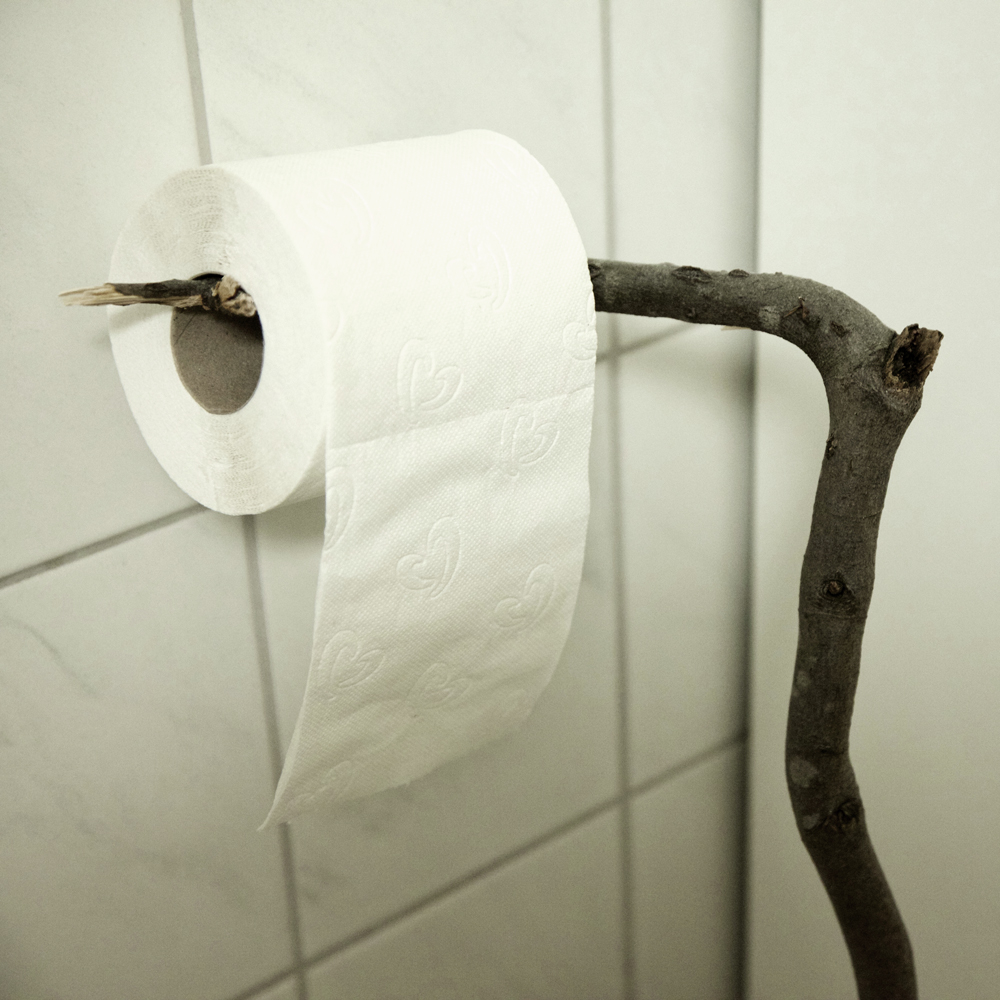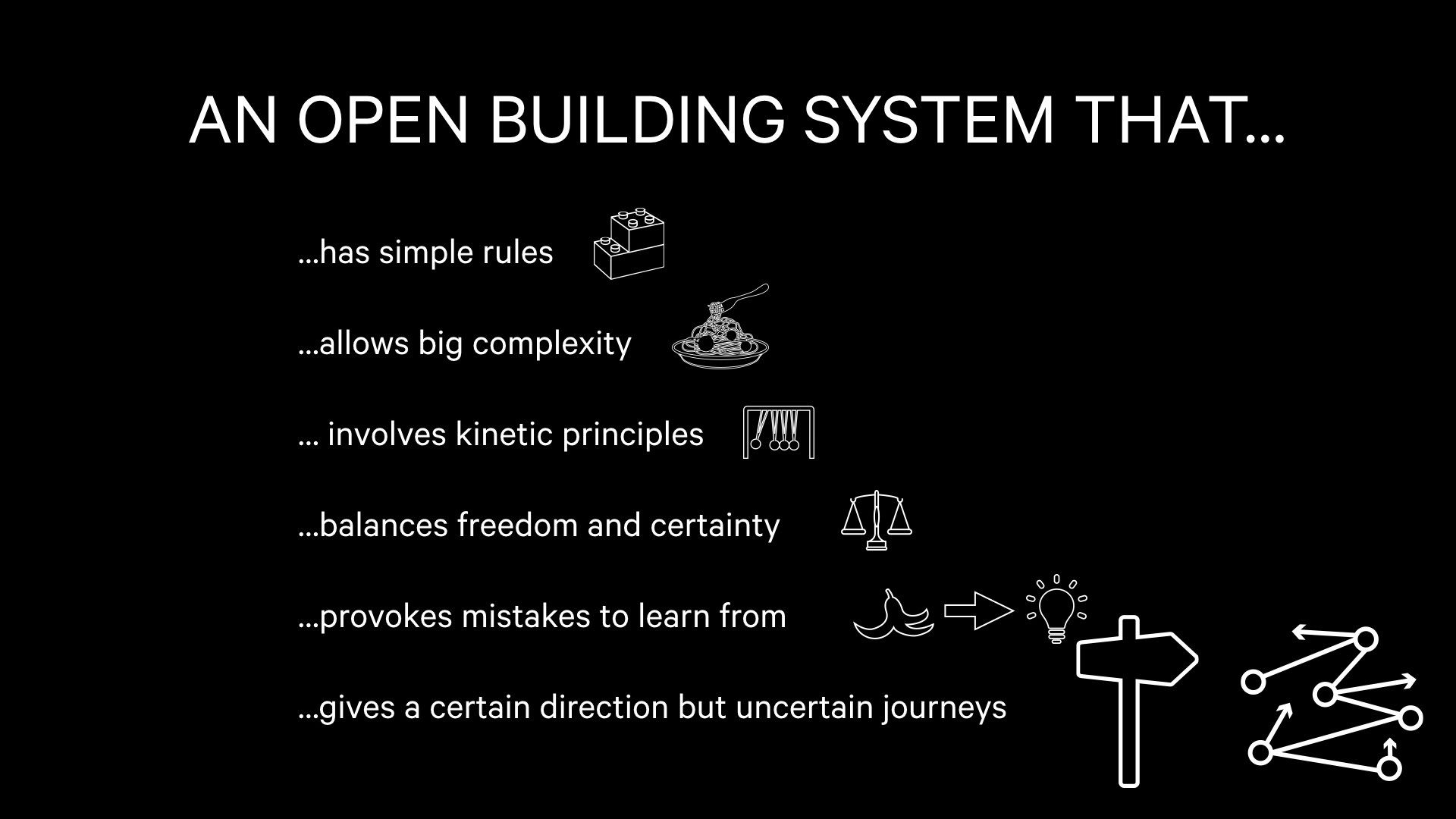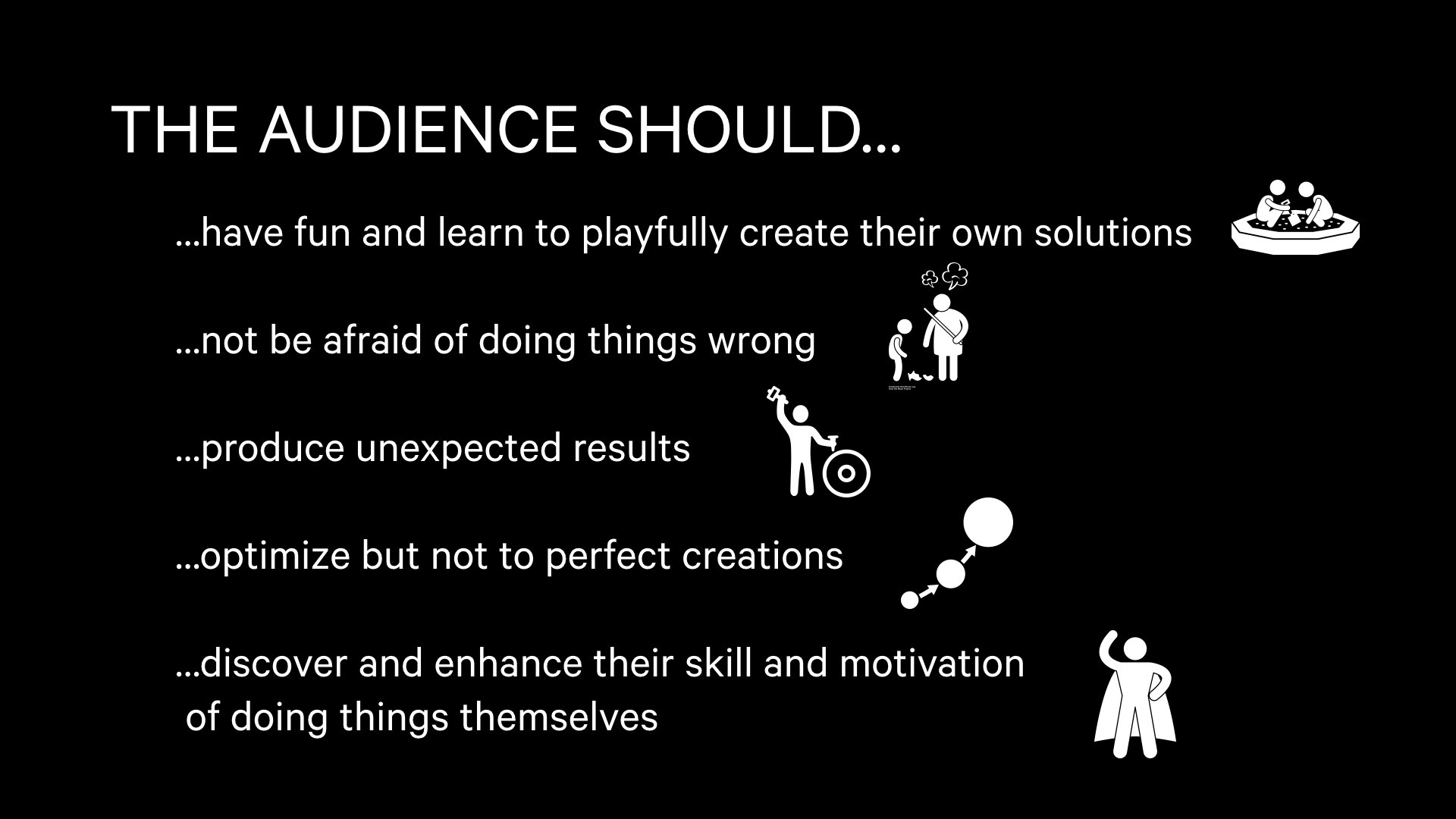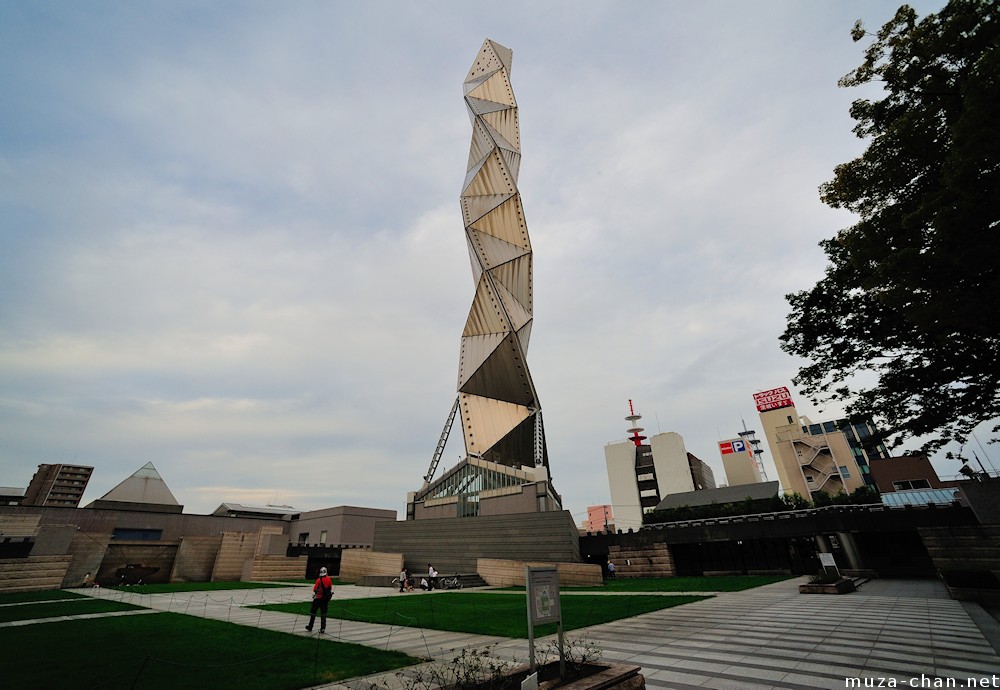RESEARCH BEHIND TAMBAS-CHAR

Thesis

From theory to practice

Project Proposal

Puzzles & Thinking Toys

Self Assembling Systems

Playful Building Systems

Generative Learning

Tetrahedral Thinking

The Math & Myth Behind

The Experience

„Oh! - Oha!? - Aha! - Haha!“
-

Thesis
This project is based on a thesis with the title „Selbermachenlassen - denn sie wissen was sie tun“ (enlg.: „Leave to self-making - they know what they do“)
The title was initiated by my own furious yet pleasureful creation process of a toilet roll holder in summer 2016. An experience that led me to the question if I could create designs that „contain“ the interaction and satisfaction of the users own making of things and sense.
It is an exploration on the subject of designs that engage people in such way that a financial or/and emotional benefit is generated from their own making processes. I discuss three ways this achieved in a broad field of designs: Whilst IKEA creates economical profit in the customers construction labour, technical and social developments led to an ongoing boom of the maker movement. In contrast to both, products like Lego have no use at all - except the joy making (possessing a self made Lego-spaceship is not the same as bricks in a loose or prebuilt assembly!).
In summary my consideration of principles reveals the idea of designing „absolute“ self-making as paradox: If a design lets you do something, it is not your own but the designers determination.
Nonetheless there is two ways of approaching values of self making through. One is finding the right balance of „undesigned freedom“ that allows (and requires!) for self-making and „predesigned certainty“ that leads to the desirable results.
Another approach is to changing the perspective pf the user as a „given limitation“ to considering his perception and ability as a potential we can exploit use through the interaction we design. By designing an experience of joy in self made creation and meanings we can initiate a self driven learning process that leads to independent yet desirable creation which not even the designer could expect. As an assumption on my statement a perspective on patterns of „evolutionary learning processes“ and their future use in machine learning is given but left for further studies.
Unfortunately this thesis was not very well received by the experts assessing so far. „You can not jump from IKEA-manuals over backing mixtures to evolution theory“ is an argument I understand but not fully agree with.
I consciously jumped borders of subject because I think this is what future - if not recent - interaction designers should do.
-

From theory to practice
Before I dived into the actual research I tried to express the basic idea
of my thesis in a speculative object.
I created a toilet roll holder that raises expectation but inevitably
breaks when unwrapped from its pesky packaging. The broken construction
leaves the user in anger and reveals a note inside: „Great! …you just broke
it. Now it’s your to shame o shine!“.
The construction allows replacement of the broken spaghetti-construction
with almost anything that has a elongate shape: A branch of a tree, a
pastry rolling pin, a candle - whatever the user finds and constructs
himself.
The result is product the user has created (or at least repaired) himself
to make up for the useless „Spaghetti-Design“. The upcoming trouble of
breaking motivates and enforces the experience of independent problem
solving. The self created solution reflects the personal achievement in the
individual look and restored function of the object.
I presented this design of experience in the recently popular format of a
„unpacking show“ as it can be found for almost any product on youtube and
other channels.
Von der Theorie zur Praxis
Kurzentschlossen - ohne viel Zeit oder Gedanken zu investieren – schuf
ich einen Prototypen, welcher den Kerngedanken meiner Theoriearbeit
veranschaulichen sollte. Wenn wir Dinge nicht aus geplanter Absicht,
sondern aus Not selber zu tun, ist dieses Erlebnis mit viel mehr
Emotion (positiver, wie negativer) verbunden. Aus diesem Grund schuf
ich ein Produkt, das viel versprach, beim Auspacken aber unweigerlich
kaputt ging. Die Enttäuschung und Frustration über die instabile
Bauweise, sollten den User motivieren, durch eine eigene Konstruktion –
welche das Objekt erlaubte – die Macht und Befriedigung des
„Selbermachens“ erleben lassen.
Das Produkt präsentierte ich im Format einer „unpacking show“, wie sie
auf Youtube verbreitet ist um das „Erlebnis des Auspackens und ersten
Augenscheins“ neuer Produkte zu vermitteln.
-

Project Proposal
I positioned this project within a certain problem space of the thesis I
wrote: I will focus on the quintessence of experience designs that induce
„selfmade“ creation through independent learning processes.
Therefore I will try to create a building system that conforms to a set of
requirements regarding the possibilities and experience of interaction.
-

Puzzles & Thinking Toys
Puzzles invite to play, to learn by doing and self-make sense and solutions. Despite those qualities, there is three common elements in the concept of puzzles, that I want to challenge with my project:
- Puzzles have only one solution. My project should have as numerous and various „meaningful“ outcomes as possible.
- They are perceived as puzzles and do not raise curiosity in meaning or function. Puzzles are not undefined things that require interpretation and independent sense-making. I want to create something as meaningless as possible.
- Require patience and curiosity: Puzzles are only appealing to people who enjoy the kind of experience I want to create already. How can I engage those people with less imagination and ambition?
Video sources & examples:
- Article on the very rare and clever Zsolt and Robert Vecse’s 20-sided Dogic Puzzle.
- Oscar van Deventers Cubic Trisection
- Puzzles from the grand Illusions toy collection presented by Tim Rowett
- There is several institutions like shapeways that produce and sell innovative puzzle-designs created by a public community.
-

Self Assembling Systems
Pieces of a building systems can not only be used as passive raw material. They can also contain knowledge and function that reveals in or through the assembly. Depending on the properties of single compartments, new patterns of and rules of assembly - through people or even more randomness - evolve. This also counts for transforming behavior of single parts in predetermined compositions.
Sources and Examples:
by Skylar Tibbits, Carrie McKnelly, Athina Papadopoulou, Chris Martin, Christophe Guberan, Baily Zuniga, Hannarae Annie Nam at Self-Assembly Lab, MIT + Autodesk Inc.
-
Playful Building Systems
Researching on playful building systems I found a large variety of
mechanisms and principles existing. Even though I proposed to create a
building system, there is a key element I want question in existing
products:
Often the learning of what and how to build is achieved through a manual or
a given purpose. I think this reduces chances of unexpected, personal or
even new creations to occur.
Conventional building elements are meant to be
combined as easily and various as possible: You could build anything with
them!
In contrast to this credo I want to explore if there is not constraints
that motivate learning and creation even more.
Videos: "K'NEX", "Krazy Gears" and "Cuboino" (by Felix Heibeck)
-
Generative Learning
I was inspired by studies towards digital simulation of evolutionary
learning processes because they include certain elements I want to involve
in my design:
- Independent creation throught learning without a designers influence.
- Various solutions for shifting definition of the problem/fitness.
- „Satisficing“ (Thesis pg. 22) instead of perfecting processes.
In comparison to real evolution digital simulation of it time can be
fast forwarded, resources never run out and physical conditions can be
changed with a mouse click.
SOURCES & EXAMPLES
Evolved Virtual Creatures
by Carls Sims (1994!), simulation of evolving creatures competing.
Article by Karl Sims
Unshackling evolution: evolving soft robots with multiple materials and
a powerful generative encoding
by Nick Cheney, Jonathan Hiller, Jeff Clune, Rob MacCurdy, Hod Lipson at
the creative
machines lab
.
Flexible Muscle-Based Locomotion for Bipedal Creatures
in ACM Transactions on Graphics, Vol. 32, Nr. 6 (Proc. of SIGGRAPH Asia
2013) Thomas Geijtenbeek, Michiel van de Panne, Frank van der Stappen
-

Tetrahedral Thinking
Bla nomal
Bla Fett
Bla Unterstrichen
BlaKursiv
The first fundamental decision in designing the proposed experience was choosing the body of tetrahedrons to be the essential space of problem solving.
Tetrahedrons provide a delightful synthesis of simplicity and complexity in both structure and function. Despite their most simple, uniform geometry we are not used to deal with tetrahedral angles because most manmade structures are based on 90° angles in orthogonal coordinate systems. Thus the properties of tetrahedrons are so unfamiliar to us that we are all „beginners“ at understanding and assembling them. Further tetrahedral bodies also have very little predetermined meaning which makes them an excellent „blank“ medium to make new sense of.
Not knowing what you deal with is an ideal condition for the joy of hands-on discovery and independent sense-making.
Personally I came across the joyful difficulties of tetrahedral geometries at least twice during my studies:
- In project „Babelbam“ (2013) I created a hammer-triggered spring mechanism that self assembled in random ways and exploded into triangular pieces.
- 2014 I failed at recreating a functional walking mechnism by Theo Jansen and hustled a quick fix solution at the very last minute before project presentation: The „Tetratrack“ (a quick fix name too). It’s a 3d-printed chain of equal tetrahedrons held together by a rubber band. Only two years Iater I found rather surprising affordance of this thing - it initiated my thoughts and experiments towards „Self Assembly“ in this project.
Both objects surprised with an addictive „touchyness“ and the unexpected shapes they forms they could take. This strongly inspired my decisions for tetrahedrons.
-

The Math & Myth Behind
Even though I based my design process on self-made experience and discovery, there is many things I didn’t need to find out myself. As the smallest platonic solid tetrahedrons provide a lot of geometric qualities that can be used as content or fascinating phenomenon in a playful learning experience.
There is a substantial fanbase of mathematicians and other scientists dealing with tetrahedral properties in theory and practice. One of wich is Stan Wagon. Since 2013 he is challenging a question raised in 1958:
„…it was proved that a chain of regular tetrahedra, meeting face to face, cannot form a perfect loop: the last tetrahedron cannot equal the first, exactly.„
In collaboration with an online community he managed to get the error of the equality down to the radius of a proton. Meanwhile Brian Hayes picked up the challenge through playing with „Geomag“ toys and contributed by 3d-printing models of Stans calculations.
Sources & Examples
- The online thread on the question.
- Stan Wagon (2016), The Quadrahelix: A Nearly Perfect Loop of Tetrahdra wrote on the matter of tetrahlix circles.
- Brian Hayes approach and models
- A very interesting 3d-view of tetrahedrix-structures in proteins by members of the Research Collaboratory for Structural Bioinformatics
-

The Experience
Play like children in an intermediate presentation of my work I tried to express the interaction, I intended to create, as simple as possible: „Play like Children!“ I claimed. By this I meant:
- Do before you know!
- Make up a sense!
- Redefine your perception and put into the next action to test and build up on it.
All Slides of the II Intermediate Presentation here.
Image sources:
- http://wallpapercraft.net/calvin-and-hobbes-backgrounds/
- www.rsvlts.com/2015/11/18/best-calvin-and-hobbes-comics/
- https://danfromsquirrelhill.files.wordpress.com/2013/12/calvinball-3.jpg
- i2.wp.com/www.museinthevalley.com/wp-content/uploads/2013/06/calvin-balloon.jpg
- s2.thingpic.com/images/e2/3gkj57yg4uK3pyyeUw63B1rw.png
-

„Oh! - Oha!? - Aha! - Haha!“
„Oh! - Oha!? - Aha! - Haha!“ is the intended experience put in expressions of reaction towards it (based on my native swiss German dialect).
- „Oh!?! - there is something“ -> Attention and motivation to interact.
- „Oha! What happens there?“ -> A phenomenon that raises curiosity.
- „Aha! - That’s how it works!“ - > Understanding through self driven interaction.
- „Haha! I am so clever and want more of this…“ -> Joy in self-made creation and sense.

Thesis

From theory to practice

Project Proposal

Puzzles & Thinking Toys

Self Assembling Systems

Playful Building Systems

Generative Learning

Tetrahedral Thinking

The Math & Myth Behind

The Experience

„Oh! - Oha!? - Aha! - Haha!“

Thesis
This project is based on a thesis with the title „Selbermachenlassen - denn sie wissen was sie tun“ (enlg.: „Leave to self-making - they know what they do“)
The title was initiated by my own furious yet pleasureful creation process of a toilet roll holder in summer 2016. An experience that led me to the question if I could create designs that „contain“ the interaction and satisfaction of the users own making of things and sense.
It is an exploration on the subject of designs that engage people in such way that a financial or/and emotional benefit is generated from their own making processes. I discuss three ways this achieved in a broad field of designs: Whilst IKEA creates economical profit in the customers construction labour, technical and social developments led to an ongoing boom of the maker movement. In contrast to both, products like Lego have no use at all - except the joy making (possessing a self made Lego-spaceship is not the same as bricks in a loose or prebuilt assembly!).
In summary my consideration of principles reveals the idea of designing „absolute“ self-making as paradox: If a design lets you do something, it is not your own but the designers determination.
Nonetheless there is two ways of approaching values of self making through. One is finding the right balance of „undesigned freedom“ that allows (and requires!) for self-making and „predesigned certainty“ that leads to the desirable results.
Another approach is to changing the perspective pf the user as a „given limitation“ to considering his perception and ability as a potential we can exploit use through the interaction we design. By designing an experience of joy in self made creation and meanings we can initiate a self driven learning process that leads to independent yet desirable creation which not even the designer could expect. As an assumption on my statement a perspective on patterns of „evolutionary learning processes“ and their future use in machine learning is given but left for further studies.
Unfortunately this thesis was not very well received by the experts assessing so far. „You can not jump from IKEA-manuals over backing mixtures to evolution theory“ is an argument I understand but not fully agree with.
I consciously jumped borders of subject because I think this is what future - if not recent - interaction designers should do.

From theory to practice
Before I dived into the actual research I tried to express the basic idea of my thesis in a speculative object.
I created a toilet roll holder that raises expectation but inevitably breaks when unwrapped from its pesky packaging. The broken construction leaves the user in anger and reveals a note inside: „Great! …you just broke it. Now it’s your to shame o shine!“.
The construction allows replacement of the broken spaghetti-construction with almost anything that has a elongate shape: A branch of a tree, a pastry rolling pin, a candle - whatever the user finds and constructs himself.
The result is product the user has created (or at least repaired) himself to make up for the useless „Spaghetti-Design“. The upcoming trouble of breaking motivates and enforces the experience of independent problem solving. The self created solution reflects the personal achievement in the individual look and restored function of the object.
I presented this design of experience in the recently popular format of a „unpacking show“ as it can be found for almost any product on youtube and other channels.
Von der Theorie zur Praxis
Das Produkt präsentierte ich im Format einer „unpacking show“, wie sie auf Youtube verbreitet ist um das „Erlebnis des Auspackens und ersten Augenscheins“ neuer Produkte zu vermitteln.

Project Proposal
I positioned this project within a certain problem space of the thesis I wrote: I will focus on the quintessence of experience designs that induce „selfmade“ creation through independent learning processes.
Therefore I will try to create a building system that conforms to a set of requirements regarding the possibilities and experience of interaction.

Puzzles & Thinking Toys
Puzzles invite to play, to learn by doing and self-make sense and solutions. Despite those qualities, there is three common elements in the concept of puzzles, that I want to challenge with my project:
- Puzzles have only one solution. My project should have as numerous and various „meaningful“ outcomes as possible.
- They are perceived as puzzles and do not raise curiosity in meaning or function. Puzzles are not undefined things that require interpretation and independent sense-making. I want to create something as meaningless as possible.
- Require patience and curiosity: Puzzles are only appealing to people who enjoy the kind of experience I want to create already. How can I engage those people with less imagination and ambition?
Video sources & examples:
- Article on the very rare and clever Zsolt and Robert Vecse’s 20-sided Dogic Puzzle.
- Oscar van Deventers Cubic Trisection
- Puzzles from the grand Illusions toy collection presented by Tim Rowett
- There is several institutions like shapeways that produce and sell innovative puzzle-designs created by a public community.

Self Assembling Systems
Pieces of a building systems can not only be used as passive raw material. They can also contain knowledge and function that reveals in or through the assembly. Depending on the properties of single compartments, new patterns of and rules of assembly - through people or even more randomness - evolve. This also counts for transforming behavior of single parts in predetermined compositions.
Sources and Examples:
by Skylar Tibbits, Carrie McKnelly, Athina Papadopoulou, Chris Martin, Christophe Guberan, Baily Zuniga, Hannarae Annie Nam at Self-Assembly Lab, MIT + Autodesk Inc.
Playful Building Systems
Researching on playful building systems I found a large variety of mechanisms and principles existing. Even though I proposed to create a building system, there is a key element I want question in existing products:
Often the learning of what and how to build is achieved through a manual or a given purpose. I think this reduces chances of unexpected, personal or even new creations to occur.
Conventional building elements are meant to be combined as easily and various as possible: You could build anything with them!
In contrast to this credo I want to explore if there is not constraints that motivate learning and creation even more.
Videos: "K'NEX", "Krazy Gears" and "Cuboino" (by Felix Heibeck)
Generative Learning
I was inspired by studies towards digital simulation of evolutionary learning processes because they include certain elements I want to involve in my design:
- Independent creation throught learning without a designers influence.
- Various solutions for shifting definition of the problem/fitness.
- „Satisficing“ (Thesis pg. 22) instead of perfecting processes.
In comparison to real evolution digital simulation of it time can be fast forwarded, resources never run out and physical conditions can be changed with a mouse click.
SOURCES & EXAMPLES
Evolved Virtual Creatures by Carls Sims (1994!), simulation of evolving creatures competing. Article by Karl Sims
Unshackling evolution: evolving soft robots with multiple materials and a powerful generative encoding by Nick Cheney, Jonathan Hiller, Jeff Clune, Rob MacCurdy, Hod Lipson at the creative machines lab .
Flexible Muscle-Based Locomotion for Bipedal Creatures in ACM Transactions on Graphics, Vol. 32, Nr. 6 (Proc. of SIGGRAPH Asia 2013) Thomas Geijtenbeek, Michiel van de Panne, Frank van der Stappen

Tetrahedral Thinking
Bla nomal
Bla Fett
Bla Unterstrichen
BlaKursiv
The first fundamental decision in designing the proposed experience was choosing the body of tetrahedrons to be the essential space of problem solving.
Tetrahedrons provide a delightful synthesis of simplicity and complexity in both structure and function. Despite their most simple, uniform geometry we are not used to deal with tetrahedral angles because most manmade structures are based on 90° angles in orthogonal coordinate systems. Thus the properties of tetrahedrons are so unfamiliar to us that we are all „beginners“ at understanding and assembling them. Further tetrahedral bodies also have very little predetermined meaning which makes them an excellent „blank“ medium to make new sense of.
Not knowing what you deal with is an ideal condition for the joy of hands-on discovery and independent sense-making.
Personally I came across the joyful difficulties of tetrahedral geometries at least twice during my studies:
- In project „Babelbam“ (2013) I created a hammer-triggered spring mechanism that self assembled in random ways and exploded into triangular pieces.
- 2014 I failed at recreating a functional walking mechnism by Theo Jansen and hustled a quick fix solution at the very last minute before project presentation: The „Tetratrack“ (a quick fix name too). It’s a 3d-printed chain of equal tetrahedrons held together by a rubber band. Only two years Iater I found rather surprising affordance of this thing - it initiated my thoughts and experiments towards „Self Assembly“ in this project.
Both objects surprised with an addictive „touchyness“ and the unexpected shapes they forms they could take. This strongly inspired my decisions for tetrahedrons.

The Math & Myth Behind
Even though I based my design process on self-made experience and discovery, there is many things I didn’t need to find out myself. As the smallest platonic solid tetrahedrons provide a lot of geometric qualities that can be used as content or fascinating phenomenon in a playful learning experience.
There is a substantial fanbase of mathematicians and other scientists dealing with tetrahedral properties in theory and practice. One of wich is Stan Wagon. Since 2013 he is challenging a question raised in 1958:
„…it was proved that a chain of regular tetrahedra, meeting face to face, cannot form a perfect loop: the last tetrahedron cannot equal the first, exactly.„
In collaboration with an online community he managed to get the error of the equality down to the radius of a proton. Meanwhile Brian Hayes picked up the challenge through playing with „Geomag“ toys and contributed by 3d-printing models of Stans calculations.
Sources & Examples
- The online thread on the question.
- Stan Wagon (2016), The Quadrahelix: A Nearly Perfect Loop of Tetrahdra wrote on the matter of tetrahlix circles.
- Brian Hayes approach and models
- A very interesting 3d-view of tetrahedrix-structures in proteins by members of the Research Collaboratory for Structural Bioinformatics

The Experience
Play like children in an intermediate presentation of my work I tried to express the interaction, I intended to create, as simple as possible: „Play like Children!“ I claimed. By this I meant:
- Do before you know!
- Make up a sense!
- Redefine your perception and put into the next action to test and build up on it.
All Slides of the II Intermediate Presentation here.
Image sources:
- http://wallpapercraft.net/calvin-and-hobbes-backgrounds/
- www.rsvlts.com/2015/11/18/best-calvin-and-hobbes-comics/
- https://danfromsquirrelhill.files.wordpress.com/2013/12/calvinball-3.jpg
- i2.wp.com/www.museinthevalley.com/wp-content/uploads/2013/06/calvin-balloon.jpg
- s2.thingpic.com/images/e2/3gkj57yg4uK3pyyeUw63B1rw.png

„Oh! - Oha!? - Aha! - Haha!“
„Oh! - Oha!? - Aha! - Haha!“ is the intended experience put in expressions of reaction towards it (based on my native swiss German dialect).
- „Oh!?! - there is something“ -> Attention and motivation to interact.
- „Oha! What happens there?“ -> A phenomenon that raises curiosity.
- „Aha! - That’s how it works!“ - > Understanding through self driven interaction.
- „Haha! I am so clever and want more of this…“ -> Joy in self-made creation and sense.


































